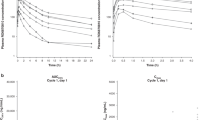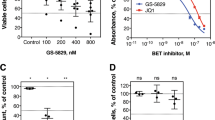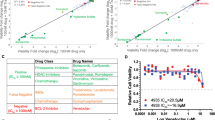Abstract
Inhibition of the bromodomain and extra-terminal (BET) proteins is a promising therapeutic strategy for various hematologic cancers. Previous studies suggest that BET inhibitors constrain tumor cell proliferation and survival mainly through the suppression of MYC transcription and activity. However, suppression of the transcription of additional genes also contributes to the antitumor activity of BET inhibitors but is less well understood. Here we examined the therapeutic potential of CPI-0610, a potent BET inhibitor currently undergoing phase I clinical testing, in multiple myeloma (MM). CPI-0610 displays potent cytotoxicity against MM cell lines and patient-derived MM cells through G1 cell cycle arrest and caspase-dependent apoptosis. CPI-0610-mediated BET inhibition overcomes the protective effects conferred by cytokines and bone marrow stromal cells. We also confirmed the in vivo efficacy of CPI-0610 in a MM xenograft mouse model. Our study found IKZF1 and IRF4 to be among the primary targets of CPI-0610, along with MYC. Given that immunomodulatory drugs (IMiDs) stabilize cereblon and facilitate Ikaros degradation in MM cells, we combined it with CPI-0610. Combination studies of CPI-0610 with IMiDs show in vitro synergism, in part due to concomitant suppression of IKZF1, IRF4 and MYC, providing a rationale for clinical testing of this drug combination in MM patients.
This is a preview of subscription content, access via your institution
Access options
Subscribe to this journal
Receive 12 print issues and online access
$259.00 per year
only $21.58 per issue
Buy this article
- Purchase on Springer Link
- Instant access to full article PDF
Prices may be subject to local taxes which are calculated during checkout








Similar content being viewed by others
References
Anderson KC, Carrasco RD . Pathogenesis of myeloma. Ann Rev Pathol 2011; 6: 249–274.
Morgan GJ, Walker BA, Davies FE . The genetic architecture of multiple myeloma. Nat Rev Cancer 2012; 12: 335–348.
Kuehl WM, Bergsagel PL . MYC addiction: a potential therapeutic target in MM. Blood 2012; 120: 2351–2352.
Chng WJ, Huang GF, Chung TH, Ng SB, Gonzalez-Paz N, Troska-Price T et al. Clinical and biological implications of MYC activation: a common difference between MGUS and newly diagnosed multiple myeloma. Leukemia 2011; 25: 1026–1035.
Dang CV . MYC on the path to cancer. Cell 2012; 149: 22–35.
Soucek L, Evan GI . The ups and downs of Myc biology. Curr Opin Genet Dev 2010; 20: 91–95.
Shaffer AL, Emre NC, Lamy L, Ngo VN, Wright G, Xiao W et al. IRF4 addiction in multiple myeloma. Nature 2008; 454: 226–231.
Lu G, Middleton RE, Sun H, Naniong M, Ott CJ, Mitsiades CS et al. The myeloma drug lenalidomide promotes the cereblon-dependent destruction of Ikaros proteins. Science 2014; 343: 305–309.
Kronke J, Udeshi ND, Narla A, Grauman P, Hurst SN, McConkey M et al. Lenalidomide causes selective degradation of IKZF1 and IKZF3 in multiple myeloma cells. Science 2014; 343: 301–305.
Delmore JE, Issa GC, Lemieux ME, Rahl PB, Shi J, Jacobs HM et al. BET bromodomain inhibition as a therapeutic strategy to target c-Myc. Cell 2011; 146: 904–917.
Chaidos A, Caputo V, Gouvedenou K, Liu B, Marigo I, Chaudhry MS et al. Potent antimyeloma activity of the novel bromodomain inhibitors I-BET151 and I-BET762. Blood 2014; 123: 697–705.
Ott CJ, Kopp N, Bird L, Paranal RM, Qi J, Bowman T et al. BET bromodomain inhibition targets both c-Myc and IL7R in high-risk acute lymphoblastic leukemia. Blood 2012; 120: 2843–2852.
Gopalakrishnan R, Matta H, Tolani B, Triche T Jr., Chaudhary PM . Immunomodulatory drugs target IKZF1-IRF4-MYC axis in primary effusion lymphoma in a cereblon-dependent manner and display synergistic cytotoxicity with BRD4 inhibitors. Oncogene 2012; 35: 1797–1810.
Picaud S, Da Costa D, Thanasopoulou A, Filippakopoulos P, Fish PV, Philpott M et al. PFI-1, a highly selective protein interaction inhibitor, targeting BET Bromodomains. Cancer Res 2013; 73: 3336–3346.
Rahman S, Sowa ME, Ottinger M, Smith JA, Shi Y, Harper JW et al. The Brd4 extraterminal domain confers transcription activation independent of pTEFb by recruiting multiple proteins, including NSD3. Mol Cell Biol 2011; 31: 2641–2652.
LeRoy G, Rickards B, Flint SJ . The double bromodomain proteins Brd2 and Brd3 couple histone acetylation to transcription. Mol 2008; 30: 51–60.
Dhalluin C, Carlson JE, Zeng L, He C, Aggarwal AK, Zhou MM . Structure and ligand of a histone acetyltransferase bromodomain. Nature 1999; 399: 491–496.
Zuber J, Shi J, Wang E, Rappaport AR, Herrmann H, Sison EA et al. RNAi screen identifies Brd4 as a therapeutic target in acute myeloid leukaemia. Nature 2011; 478: 524–528.
Mertz JA, Conery AR, Bryant BM, Sandy P, Balasubramanian S, Mele DA et al. Targeting MYC dependence in cancer by inhibiting BET bromodomains. Proc Natl Acad Sci USA 2011; 108: 16669–16674.
Dawson MA, Prinjha RK, Dittmann A, Giotopoulos G, Bantscheff M, Chan WI et al. Inhibition of BET recruitment to chromatin as an effective treatment for MLL-fusion leukaemia. Nature 2011; 478: 529–533.
Chng WJ, Kumar S, Vanwier S, Ahmann G, Price-Troska T, Henderson K et al. Molecular dissection of hyperdiploid multiple myeloma by gene expression profiling. Cancer Res 2007; 67: 2982–2989.
Santo L, Vallet S, Hideshima T, Cirstea D, Ikeda H, Pozzi S et al. AT7519, A novel small molecule multi-cyclin-dependent kinase inhibitor, induces apoptosis in multiple myeloma via GSK-3beta activation and RNA polymerase II inhibition. Oncogene 2010; 29: 2325–2336.
Santo L, Hideshima T, Kung AL, Tseng JC, Tamang D, Yang M et al. Preclinical activity, pharmacodynamic, and pharmacokinetic properties of a selective HDAC6 inhibitor, ACY-1215, in combination with bortezomib in multiple myeloma. Blood 2012; 119: 2579–2589.
Raje N, Hideshima T, Mukherjee S, Raab M, Vallet S, Chhetri S et al. Preclinical activity of P276-00, a novel small-molecule cyclin-dependent kinase inhibitor in the therapy of multiple myeloma. Leukemia 2009; 23: 961–970.
Cirstea D, Hideshima T, Santo L, Eda H, Mishima Y, Nemani N et al. Small-molecule multi-targeted kinase inhibitor RGB-286638 triggers P53-dependent and -independent anti-multiple myeloma activity through inhibition of transcriptional CDKs. Leukemia 2013; 27: 2366–2375.
Albrecht BK, Gehling VS, Hewitt MC, Vaswani RG, Cote A, Leblanc Y et al. Identification of a benzoisoxazoloazepine inhibitor (CPI-0610) of the bromodomain and extra-terminal (BET) family as a candidate for human clinical trials. J Med Chem 2016; 59: 1330–1339.
Tolani B, Gopalakrishnan R, Punj V, Matta H, Chaudhary PM . Targeting Myc in KSHV-associated primary effusion lymphoma with BET bromodomain inhibitors. Oncogene 2014; 33: 2928–2937.
Hideshima T, Mitsiades C, Tonon G, Richardson PG, Anderson KC . Understanding multiple myeloma pathogenesis in the bone marrow to identify new therapeutic targets. Nat Rev Cancer 2007; 7: 585–598.
Hideshima T, Anderson KC . Molecular mechanisms of novel therapeutic approaches for multiple myeloma. Nat Rev Cancer 2002; 2: 927–937.
Santo L, Hideshima T, Cirstea D, Bandi M, Nelson EA, Gorgun G et al. Antimyeloma activity of a multitargeted kinase inhibitor, AT9283, via potent Aurora kinase and STAT3 inhibition either alone or in combination with lenalidomide. Clin Cancer Res 2011; 17: 3259–3271.
Chou TC, Talalay P . Quantitative analysis of dose-effect relationships: the combined effects of multiple drugs or enzyme inhibitors. Adv Enzyme Regul 1984; 22: 27–55.
Loven J, Hoke HA, Lin CY, Lau A, Orlando DA, Vakoc CR et al. Selective inhibition of tumor oncogenes by disruption of super-enhancers. Cell 2013; 153: 320–334.
Filippakopoulos P, Knapp S . Targeting bromodomains: epigenetic readers of lysine acetylation. Nature Rev Drug Discov 2014; 13: 337–356.
Shi J, Vakoc CR . The mechanisms behind the therapeutic activity of BET bromodomain inhibition. Mol Cell 2014; 54: 728–736.
Lonial S, Kaufman JL . The era of combination therapy in myeloma. J Clin Oncol 2012; 30: 2434–2436.
Acknowledgements
We thank members of Dr David Scadden’s laboratory: David Sykes, Youmna Kfoury, Francois Mercier, Dongjun Lee, Ninib Baryawno, Nicolas Sévère, Karin Gustafsson and Demetrios Kalaitzidis at Massachusetts General Hospital for helpful discussion. This work is supported by the Multiple Myeloma Research Fund at MGH. Constellation Pharmaceuticals, Inc., provided the CPI-0610 compound.
Author information
Authors and Affiliations
Corresponding author
Ethics declarations
Competing interests
JAM, RJS and MRC are employees and shareholders of Constellation Pharmaceuticals. NR is on advisory boards of Amgen, Bristol-Myers Squibb, Celgene Corporation and Takeda. NR has received research funding from AstraZeneca and Eli Lilly. The remaining authors declare no conflict of interest.
Additional information
Supplementary Information accompanies this paper on the Leukemia website
Supplementary information
Rights and permissions
About this article
Cite this article
Siu, K., Ramachandran, J., Yee, A. et al. Preclinical activity of CPI-0610, a novel small-molecule bromodomain and extra-terminal protein inhibitor in the therapy of multiple myeloma. Leukemia 31, 1760–1769 (2017). https://doi.org/10.1038/leu.2016.355
Received:
Revised:
Accepted:
Published:
Issue Date:
DOI: https://doi.org/10.1038/leu.2016.355
This article is cited by
-
Targeting bromodomain-containing proteins: research advances of drug discovery
Molecular Biomedicine (2023)
-
Characterization and application of a lactate and branched chain amino acid metabolism related gene signature in a prognosis risk model for multiple myeloma
Cancer Cell International (2023)
-
The effects of MYC on tumor immunity and immunotherapy
Cell Death Discovery (2023)
-
Role of HOXA9 in solid tumors: mechanistic insights and therapeutic potential
Cancer Cell International (2022)
-
BRD4 drives esophageal squamous cell carcinoma growth by promoting RCC2 expression
Oncogene (2022)



